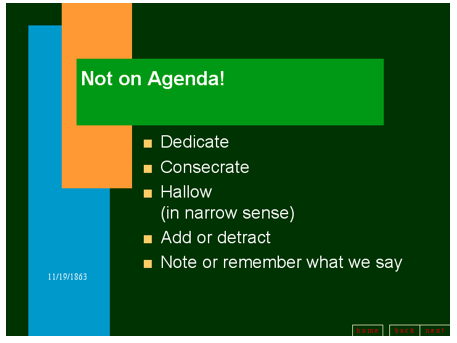Death by Powerpoint

Implicated in 2 space shuttle disasters. Banned by a combat commander in Iraq. Making sense of our collected and stored information is hard enough. Does PowerPoint thinking make it harder?
The New York Times quotes Marine Corps Gen. James N. Mattis: "PowerPoint makes us stupid." And Brig. Gen. H. R. McMaster, who banned PowerPoint presentations when he led the fight to secure the Iraqi city of Tal Afar, likened PowerPoint to an internal threat.
An Army platoon leader in Iraq, Lt. Sam Nuxoll, said he spent most of his time “Making PowerPoint slides.” When pressed, he said he was serious.
According to the book “Fiasco” by Thomas E. Ricks, Gen. Tommy R. Franks, who commanded American forces, did not issue explicit orders on how he wanted the invasion conducted, and why. Instead, General Franks just passed on the vague PowerPoint slides that he had shown to defense secretary Donald H. Rumsfeld.
Edward Tufte, a Yale professor emeritus, and the author of The Visual Display of Quantitative Information makes a deeper critique of PowerPoint in The Cognitive Style of PowerPoint.
- Cognitive style. Presenter-focused, not content or audience focused.
- Low resolution. Little info per slide - so more slides are needed. Data graphics are weak: average of 12 numbers per graphic.
- Bullets. Bullet lists can show only 3 logical flows: sequence; priority; or membership. Multivariate models with feedback and simultaneity can't be listed. This encourages lazy thinking, generic ideas and ignores critical relationships and assumptions.
The Gettysburg PowerPoint Tufte doesn't mention PowerPoint's impact on eloquence, but Peter Norvig's hilarious Gettysburg PowerPoint makes the case. Using the AutoContent Wizard and the "Company Meeting (Online)" template, he quickly created a garish and unmemorable hash of the most famous speech in US Presidential history.
As Doc Searls put it:
. . . the PowerPoint "Wizard" is this Nazi interrogator who says "Vee haff vays uff making you talk."
The shuttle disasters Richard Feynman, the late Nobel laureate and CalTech physicist, saw that "bulletized" thinking contributed to the Challenger disaster, where 7 crew members died and a multi-billion dollar craft destroyed due to an O-ring failure. The big problem was that NASA management wasn't really listening to the engineers - and breaking issues up into bullets helped them do that.
We looked at the summary of the report. Everything was behind little bullets, as usual. The top line says:
- The lack of a good secondary seal in the field joint is most critical and ways to reduce joint rotation should be incorporated as soon as possible to reduce criticality.
And then, near the bottom, it says:
- Analysis of existing data indicates that it is safe to continue flying existing design as long as all joints are leak checked* with a 200 psig stabilization . . .
I was struck by the contradiction: "If it's 'most critical,' how could it be 'safe to continue flying'? What's the logic of this?"
[What do you care what other people think? page 135]
The engineers who worked on the Challenger O-rings knew they weren't qualified for cold weather. But management didn't want to hear it and OK'd the launch despite the engineer's opposition.
As sometimes happens, disaster ensued.
In the 2003 Columbia shuttle disaster, Prof. Tufte dissects the PowerPoint slides that buried important information - such as volume, mass and velocity - about the large piece of foam insulation that penetrated the Columbia's heat shield. Creating useful engineering reports in PowerPoint is difficult if not impossible.
The Storage Bits take PowerPoint - and Keynote, its prettier Mac cousin - are only tools, albeit very popular tools. Give a man a hammer and everything looks like a nail.
Update: PowerPoint is a hammer. It does some things well and others - such as presenting complex ideas - poorly, no matter how gifted the presenter. There are many ways to engage an audience with minimal text - watch Steve Jobs present - and 1 of the best is with a story. End update.
A critical issue is that PowerPoint is a tool for presentation, not discussion. In a multivariate world, we need more discussion, not less.
That lack of discussion exists in an organizational context that values hierarchy and control. A business plan is written, a presentation given to management - who will not read the plan - and the plan is approved without serious thought. Management's prerogatives have been honored.
Combine that with the all-too-human reluctance to think (see "dittoheads") and the popularity of PowerPoint is clear: it creates the illusion of participation without the sweaty bits. Getting into issues requires the hard work of questioning assumptions, examining evidence, determining values and accepting compromises.
That's discussion, not presentation.
Comments welcome, of course. The most stunning PowerPoint presentation I've seen was 53 slides on part numbers. Amazing!
Update: Check out Prezi for a creative alternative to PP/KN. I don't like their business model, but they have a lot of great ideas. End update.
